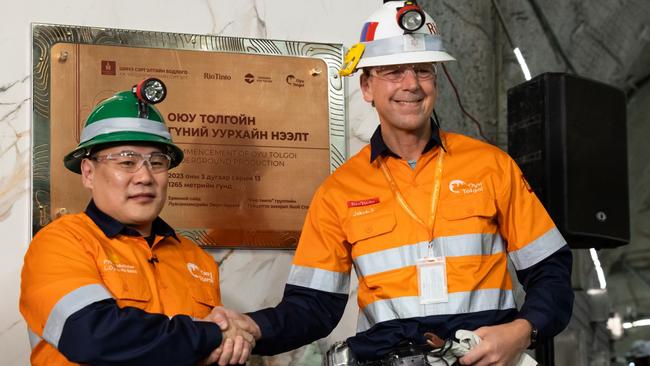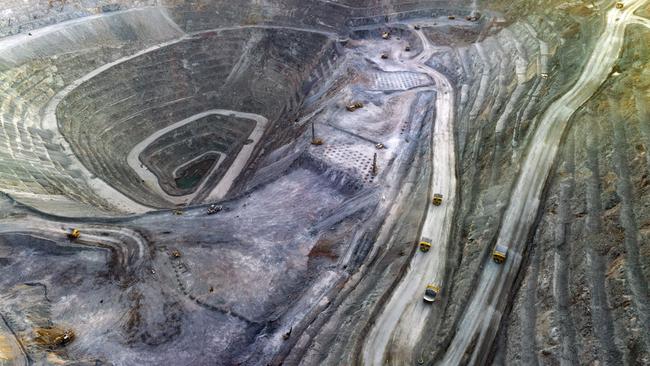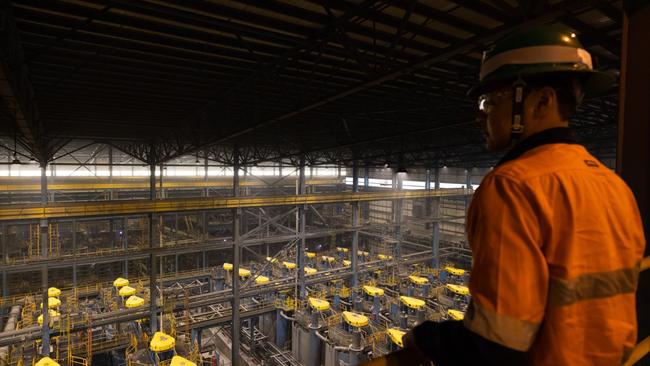‘It’s personal’: How a mine in Mongolia is ground zero for Rio Tinto chief’s reinvention plan
A massive mine expansion in landlocked Mongolia can change the fortunes of a once closed country and the direction of the mining giant.

It’s a crisp, chilly morning deep in the southern Gobi desert and Jakob Stausholm is standing outside on the tarmac of a single runway airport.
The chief executive of $170bn miner Rio Tinto is wearing a thick high-vis work shirt with the name “Jacob S”, sewn in white just below his company’s logo on the front right pocket. He is stamping heavy boots from side to side on the near frozen ground as he waits for the private jet carrying the Prime Minister of Mongolia to pull to a halt outside the terminal that services the country’s huge copper mine.
The moment where Stausholm extends a welcoming hand to Luvsannamsrain Oyun-Erdene has been decades in the making but has come at a cost, including bruising negotiations on both sides and a direct cash outlay for Rio of more than $US7bn ($10.5bn).
A massive expansion is an all-in bet that is set to reshape the mining giant and the landlocked Mongolia that until 30 years ago had been largely dependent on the Soviet Union for much of its survival.
Processing the first ore from the new underground mine is a pivotal moment, with the remote Oyu Tolgoi mine that is jointly owned by Rio and the Mongolian government representing something about both of their futures.
For the mining giant, the ambition is twofold. It provides a path to diversify away from the dominant iron ore mines it operates in the Pilbara by doubling its copper output.
It is also a chance to show the world that Rio can learn from its mistakes and be a better corporate citizen. This helps earn its licence to operate in countries such as Australia, Canada and the US, where it is already well established, while being seen as a good partner for future projects where it hopes to one day develop an iron ore mine in Guinea or even lithium in Serbia.
And for Mongolia, a young country with nomadic farming roots whose annual economic output is eclipsed by Rio’s yearly earnings, it represents financial certainty for decades to come. More than a windfall, it will give its people of a little more than 3 million the skills and investment to build out a modern economy. It also shows it is prepared to stand up to a multinational and extract a better deal for its people.

An emotional Stausholm cautions “he might get carried away” by the occasion.
“As business leaders, we are here to solve problems. And we have had our share of challenges. But this is a day of celebration.” And there is a deep sense of pride among the thousands of staff who have been involved in building a huge mine more than 1km underground and all the associated tunnelling and infrastructure around it. The project has a record as one of the safest mines in the world, Stausholm adds.
“I am very humble about that,” he says.
After being given a safety induction and hard hats and checking their ID cards on the mine’s tagboard, Stausholm and Oyun-Erdene took the 1.2km ride in a steel cage elevator that is big enough to carry a small truck.
From there the two declared the underground expansion of the Oyu Tolgoi copper mine open. After years of construction, this will boost production to 500,000 tonnes of copper concentrate annually. This is up from a little over 110,000 tonnes annually being produced over the past decade from Stage 1 – the nearby open-pit mine that still has years of life left.
However, the higher grades of the ore deep below the surface reduce costs and offers substantial expansion options. Copper is used in everything from iPhones to air conditioners. But the metal is highly sought after as a critical mineral that will power the renewables revolution. Wind turbines and electric vehicles have sharply increased the demand for copper. The megatrend of decarbonisation will add additional demand on top of growing demand as the global economy expands.

As one of the world’s biggest accessible copper deposits, Oyu Tolgoi at its peak will produce enough copper to produce more than 16,000 electric vehicles a day. The ore it mines is crushed and processed on site, concentrated, packed into two-tonne bags and trucked to a transport facility at the nearby Chinese border.
Oyu Tolgoi is a million miles from anywhere although it sits right on China’s northern doorstep. The Gobi desert’s bone-dry rocky surface would be perfect for shooting a film set on Mars.
The temperatures get bitingly cold, at times pushing -35C, but it’s the sub-zero winds that gets you in the end. When they roar, it can seemingly freeze you in an instant.
But through this, Rio has built a small city that can house up to 10,000 at a time. It has all the comforts of Wi-Fi and quiet offices bursting with staff sitting at flat-screen computers that betray the howling wind outside. There’s a cinema, supermarket and gym that runs jujitsu competitions on Thursdays. Some 6000 staff fly into the site each week. The catering hall is an exercise in logistics, making 21,000 hot meals a day.

Speaking underground, Oyun-Erdene says the mine will be important to supply the world’s renewable shift. He also acknowledges a tough journey along the way with Rio over the years. But this had been “driven by the desire to maximise the benefits of the project” for Mongolia’s people.
After a reset last year Rio is once again a trusted partner and the beginning of underground operations shows Mongolia is “open for business,” he adds.
To show the importance of the mine to the country, the annual economic output of Mongolia is worth $US15bn, with the Oyu Tolgoi open-pit mine currently contributing up a third of that.
As underground production ramps up towards the end of the decade, it will then represent nearly half the country’s annual economic output.
With so much of the country’s fortunes tied up with just one company, this creates a prisoners dilemma. It makes Mongolia too reliant on one income stream, potentially setting it up for a massive economic shock as commodity cycles swing. And for Rio, it carries even broader social responsibilities. Small operational decisions about the mine – such as whether to introduce robotic trucks – could have outsized implications, potentially triggering social stresses.
At the same time having China as Mongolia’s biggest trading partner at times representing as much as 90 per cent of foreign income, this piles risk on top of risk.
The Mongolian government is acutely aware of this and is determined to broaden its economy. This extends to seeking development from other miners while building out options in tourism, agriculture and logistics. All will require investment and all need the right skills. It also requires the hard stuff of the right customs infrastructure and road and rail links to improve connections with the rest of the world.
“We realised that our economy is very much reliant on the mining sector,” Mongolia’s Border Control Minister Bulgantuya Khurelbaatar says.

“We do have our concerns, because that means the economy will be very volatile with commodity prices. You still have to finance healthcare, education whether it’s an economic downturn or not. You still have to issue your pensions. So this is why the government is taking initiative to diversify the economy.”
Both Rio and the Mongolian government – which owns 34 per cent of Oyu Tolgoi – openly acknowledge the problems the two have had over the development.
“It’s not been a smooth ride,” Stausholm says. “But we have learned like you wouldn’t believe. And this has made us stronger.”
There were bitter disputes over demands around investment and revenue sharing. At one point this resulted in construction of the underground mine halting for nearly two years. Then the onset of pandemic sharply slowed development and pushed up costs. At one point workers were required to isolate for up to six weeks just to step foot on the site.
Adding to this, while Rio was the mine operator, its exposure was through the majority ownership of Canadian-listed miner Turquoise Hill, the company previously known as Ivanhoe Mines that was founded by Canadian explorer Robert Friedland.
Stausholm, a Danish national, joined Rio five years ago from global shipping giant Maersk. He started as chief financial officer but was quickly elevated into the top job two years ago when former boss JS Jacques was ejected following the Juukan Gorge cave destruction scandal.
Stausholm has so far spent most of his time repairing relations with people and the countries where Rio operates, after the miner over the years developed a reputation of arrogance and ignoring social and political issues.
In January last year a deal had been reached substantially resetting the relationship between Rio and Ulaanbaatar. Rio agreed to waive $US2.4bn in financing loans plus interest that was owed by Mongolia. It also recut revenue sharing and thrashed out a plan to support the investment needed to get renewable power generation on site and into the Mongolian grid.

Currently the mine’s power supply comes from nearby China.
There are still outstanding issues around tax take, but this is in arbitration and both sides are confident an outcome can be reached.
Stausholm says the past year has been about winning back credibility with the government by showing Rio is delivering on its plans. The last piece of the puzzle came in December last year, when Stausholm paid $US3.3bn to buy out Turquoise Hill to untangle the ownership web.
“Every time there was an issue and we needed to talk to the (Mongolian) government … we had to go to Turquoise and their lawyers had to assess whether it was material and whether they had to do with disclosure before we can talk to the government,” Stausholm says. “As a working relationship it didn’t work”.
For Stausholm, getting to the point of opening the underground expansion has been a personal journey. “When I took over two years ago it was very clear Oyu Tolgoi was one of the biggest opportunities but also challenges, and it was not entirely clear how to solve it,” he says.
“I knew instinctively already when I was interviewed for the job that I wanted Bold Baatar to take over copper and try to solve it.
“We needed to rebuild relationships and it was a first vote of confidence to Mongolia.”
Today Stausholm says Mongolia and its Oyu Tolgoi employees have become “a very important part of the Rio Tinto family”. The mine counts 97 per cent of its workforce as Mongolians, including a high proportion of women. Mongolians work across all levels, from giant haul truck operators to electricians, computer programmers and site managers. Copper chief Baatar, who also oversees the mine, is a Mongolian national.
Indeed there are now Mongolian mining staff working all through Rio’s global operations, including families at its Kennecott copper mine in Utah.
“Now we are trying to go underground at our copper mine and the Kennecott people are saying ‘we don’t really have underground expertise’. Well we have it here,” Stausholm says.
“And actually, when you look at what we have spent the last 10 years, we have only spent more money in Australia. Canada and Mongolia are about the same level and this just tells you something about the bet that we have made here in Mongolia”.
The author visited Oyu Tolgoi, Mongolia as a guest of Rio Tinto


To join the conversation, please log in. Don't have an account? Register
Join the conversation, you are commenting as Logout